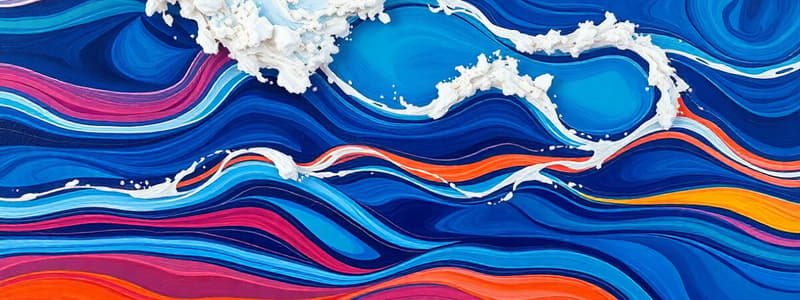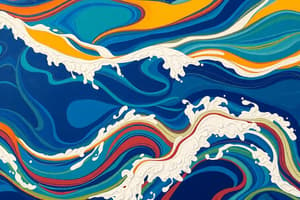Podcast
Questions and Answers
Which factors influence surface currents?
Which factors influence surface currents?
- Wave height, Moon phase, Iceberg presence
- Wind, Earth rotation, Shape of continents (correct)
- Salinity, Deep water pressure, Ocean depth
- Temperature, Soil Composition, Sunlight
What effect does the rotation of the Earth have on currents?
What effect does the rotation of the Earth have on currents?
- It causes air density to increase.
- It deflects winds and currents based on their location relative to the equator. (correct)
- It prevents surface currents from forming.
- It causes currents to flow faster in the Northern Hemisphere.
What is the primary reason deep water currents are influenced?
What is the primary reason deep water currents are influenced?
- Waves and tides
- Water temperature and salinity (correct)
- Wind speed and direction
- Earth's rotation and continental shapes
What happens to waves as they approach the shoreline?
What happens to waves as they approach the shoreline?
What distinguishes breakers from swells?
What distinguishes breakers from swells?
Which statement accurately describes tides?
Which statement accurately describes tides?
What are tsunamis primarily caused by?
What are tsunamis primarily caused by?
How does salinity affect ocean water?
How does salinity affect ocean water?
What role do oceans play in the water cycle?
What role do oceans play in the water cycle?
Which process contributed to the formation of ocean basins?
Which process contributed to the formation of ocean basins?
How do tectonic plates influence ocean systems?
How do tectonic plates influence ocean systems?
What technology is commonly used for underwater exploration?
What technology is commonly used for underwater exploration?
Which of the following is NOT a feature of the continental margin?
Which of the following is NOT a feature of the continental margin?
What is a primary characteristic of abyssal plains?
What is a primary characteristic of abyssal plains?
What is one major function of ocean currents?
What is one major function of ocean currents?
What natural event can lead to the release of water vapor that contributes to the oceans?
What natural event can lead to the release of water vapor that contributes to the oceans?
What primarily causes the movement of surface currents in the ocean?
What primarily causes the movement of surface currents in the ocean?
How does the shape of the Earth's continents affect ocean currents?
How does the shape of the Earth's continents affect ocean currents?
What is the main characteristic of deep water currents?
What is the main characteristic of deep water currents?
What defines a breaker wave compared to a swell wave?
What defines a breaker wave compared to a swell wave?
Which of the following factors primarily affects the salinity of ocean water?
Which of the following factors primarily affects the salinity of ocean water?
What is the Coriolis effect responsible for in relation to ocean currents?
What is the Coriolis effect responsible for in relation to ocean currents?
Which phenomenon is associated with the rise and fall of ocean water levels?
Which phenomenon is associated with the rise and fall of ocean water levels?
What are tsunamis primarily characterized by?
What are tsunamis primarily characterized by?
What is one of the primary roles of oceans in the ecosystem?
What is one of the primary roles of oceans in the ecosystem?
Which process contributes to the shaping of ocean basins and the creation of the ocean floor?
Which process contributes to the shaping of ocean basins and the creation of the ocean floor?
Which of the following is a technology used for underwater exploration?
Which of the following is a technology used for underwater exploration?
Which of the following best describes the continental slope?
Which of the following best describes the continental slope?
What is the role of erosion in ocean systems?
What is the role of erosion in ocean systems?
How do glaciers contribute to the ocean systems?
How do glaciers contribute to the ocean systems?
What is the primary characteristic of mid-ocean ridges?
What is the primary characteristic of mid-ocean ridges?
Which organization is involved in ocean research in Canada?
Which organization is involved in ocean research in Canada?
Flashcards
Continental Shelf
Continental Shelf
The submerged part of a continent that extends from the shoreline to the edge of a basin.
Continental Slope
Continental Slope
The steep slope that marks the transition from the continental shelf to the deep ocean floor.
Abyssal Plain
Abyssal Plain
A wide, flat expanse of the ocean floor, typically covered with sediments.
Mid-Ocean Ridge
Mid-Ocean Ridge
Signup and view all the flashcards
Ocean Current
Ocean Current
Signup and view all the flashcards
Sonar
Sonar
Signup and view all the flashcards
Deep Sea Submersibles
Deep Sea Submersibles
Signup and view all the flashcards
Core Sampling
Core Sampling
Signup and view all the flashcards
Surface Currents
Surface Currents
Signup and view all the flashcards
Deep Currents
Deep Currents
Signup and view all the flashcards
Wind
Wind
Signup and view all the flashcards
Earth Rotation (Coriolis Effect)
Earth Rotation (Coriolis Effect)
Signup and view all the flashcards
Shape of Continents
Shape of Continents
Signup and view all the flashcards
Water Temperature
Water Temperature
Signup and view all the flashcards
Salinity
Salinity
Signup and view all the flashcards
Waves
Waves
Signup and view all the flashcards
What are surface currents?
What are surface currents?
Signup and view all the flashcards
What are deep ocean currents?
What are deep ocean currents?
Signup and view all the flashcards
What is the Coriolis Effect?
What is the Coriolis Effect?
Signup and view all the flashcards
How do continents influence surface currents?
How do continents influence surface currents?
Signup and view all the flashcards
What are tsunamis and what causes them?
What are tsunamis and what causes them?
Signup and view all the flashcards
What are tides?
What are tides?
Signup and view all the flashcards
What are swells?
What are swells?
Signup and view all the flashcards
What are breakers?
What are breakers?
Signup and view all the flashcards
Erosion's role in ocean formation
Erosion's role in ocean formation
Signup and view all the flashcards
Volcanic action and ocean formation
Volcanic action and ocean formation
Signup and view all the flashcards
What are abyssal plains?
What are abyssal plains?
Signup and view all the flashcards
What are mid-ocean ridges?
What are mid-ocean ridges?
Signup and view all the flashcards
What are ocean currents?
What are ocean currents?
Signup and view all the flashcards
What are deep currents?
What are deep currents?
Signup and view all the flashcards
How does sonar work?
How does sonar work?
Signup and view all the flashcards




